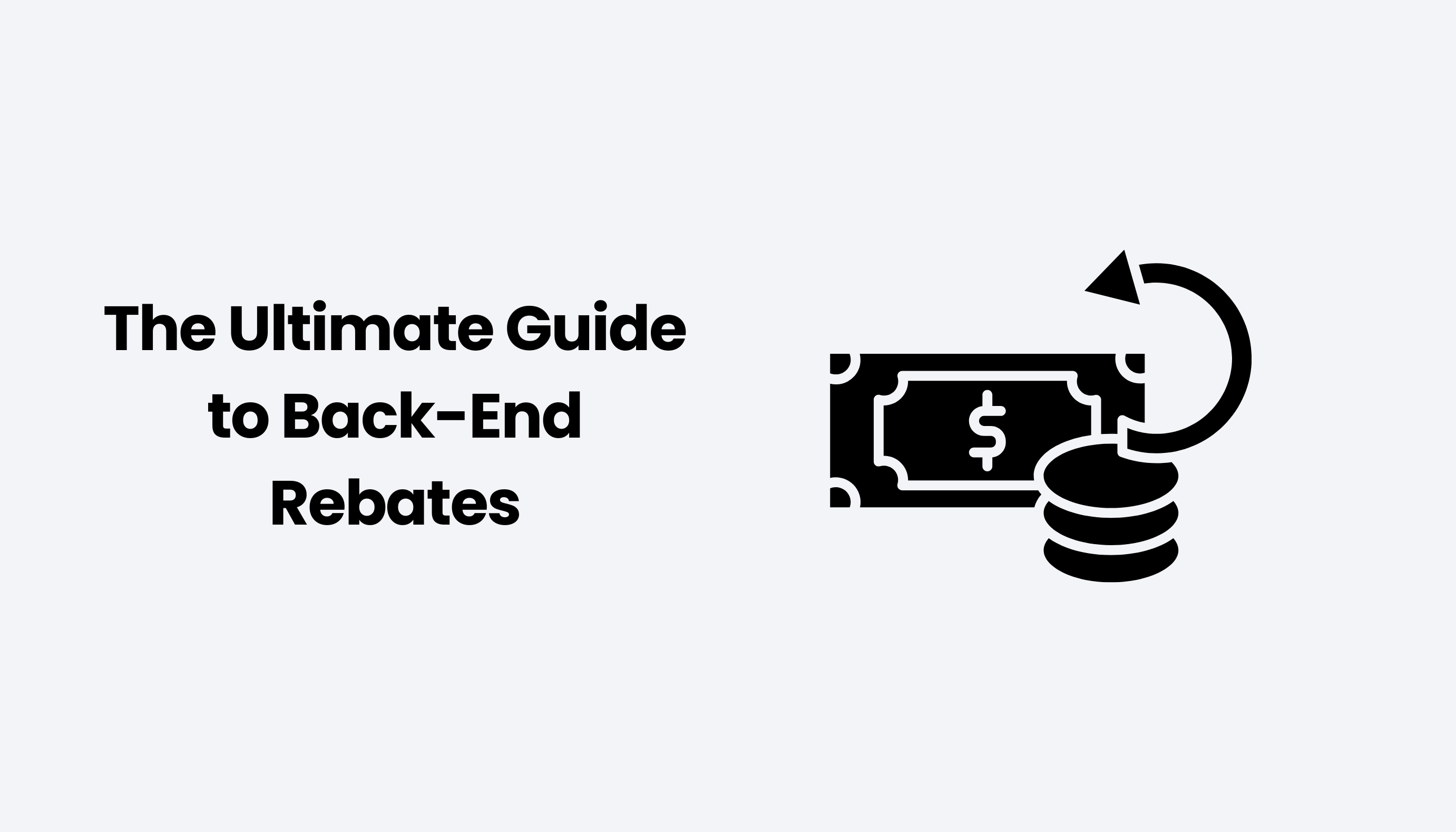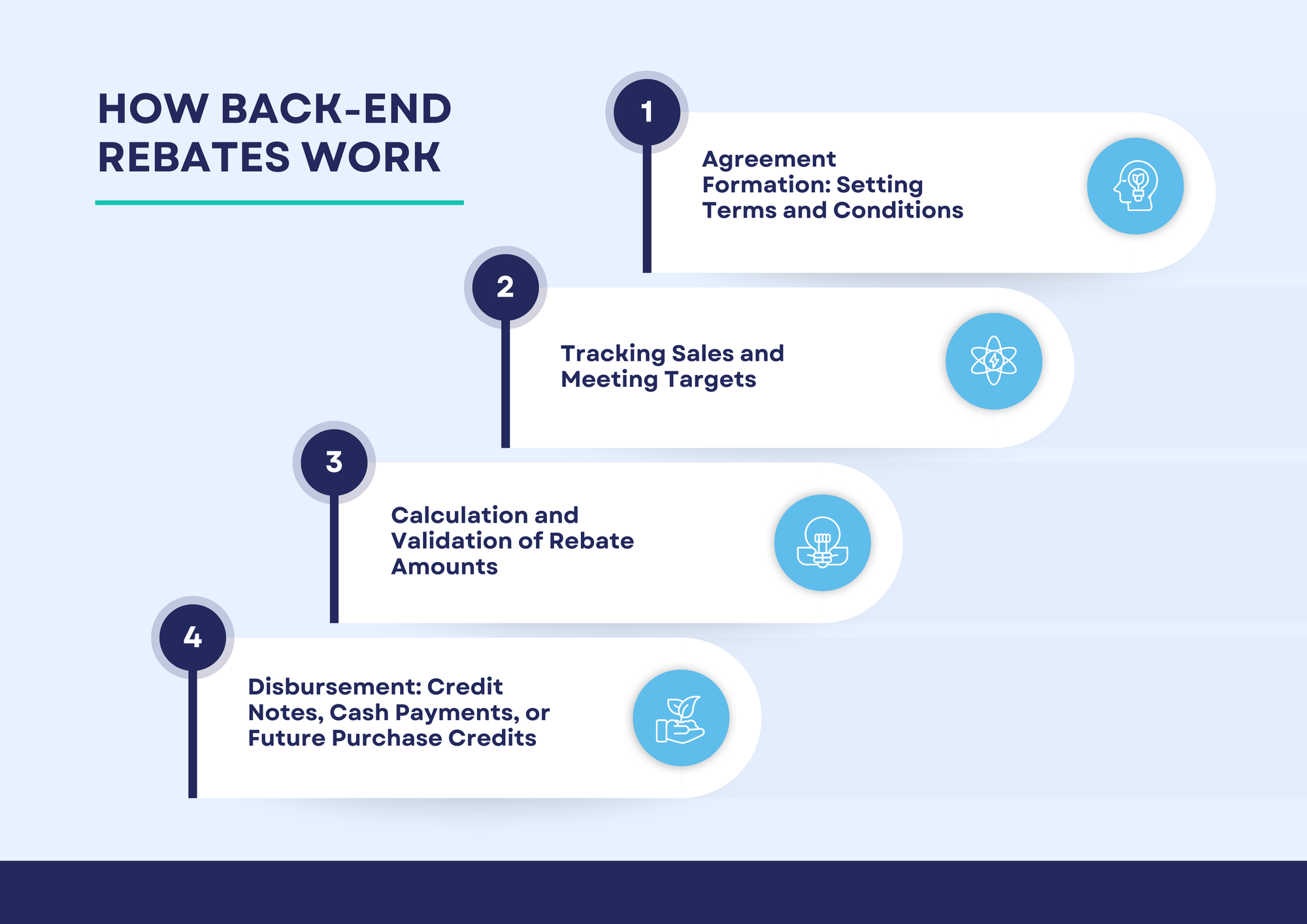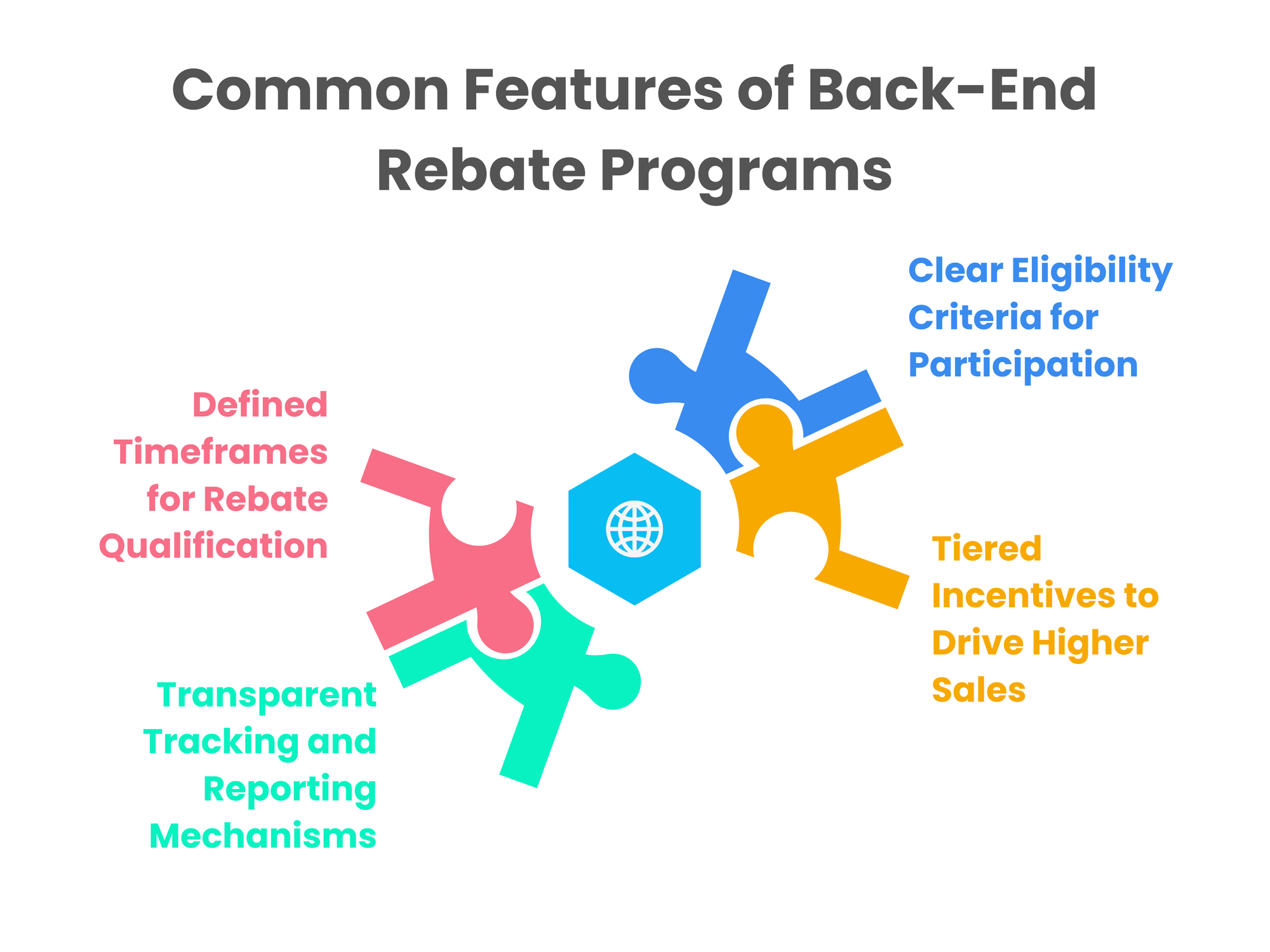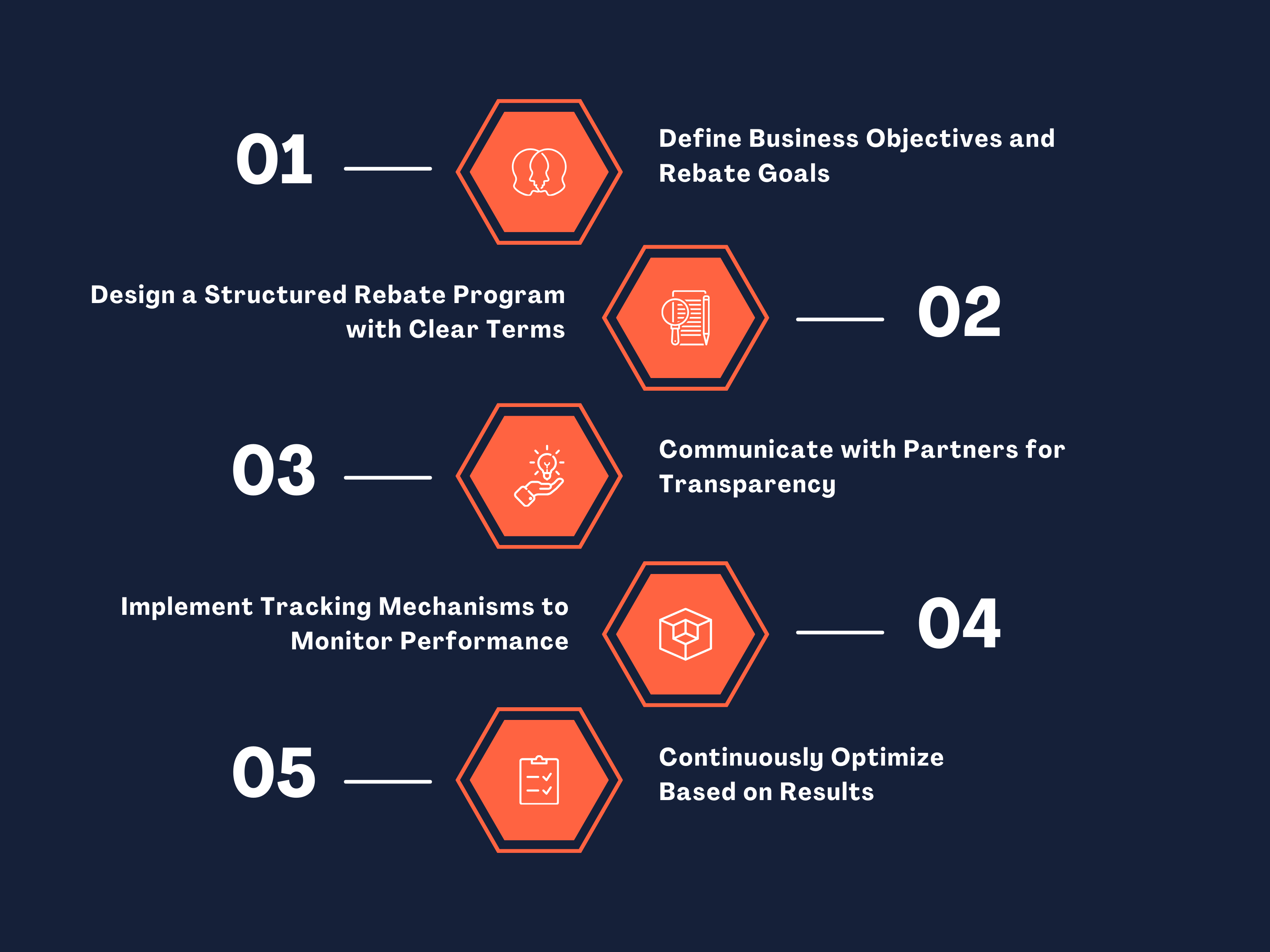The Ultimate Guide to Back-End Rebates

Back-end rebates play a crucial role in modern business strategies, particularly in industries where sales volume, partner loyalty, and price stability are key factors. Unlike upfront discounts, which provide immediate price reductions, back-end rebates serve as performance-based incentives, rewarding distributors and retailers for achieving specific targets over a set period. These rebates help companies maintain control over pricing, encourage bulk purchasing, and strengthen relationships with channel partners. While they offer financial benefits, managing them requires careful planning, clear documentation, and robust tracking systems to prevent delays and disputes. This guide provides a comprehensive look at how back-end rebates work, their advantages and challenges, and best practices for implementation to ensure businesses maximize their effectiveness.
Table of Contents:
- What Are Back-End Rebates?
- How Back-End Rebates Work?
- Benefits of Back-End Rebates
- Challenges of Managing Back-End Rebates
- Common Features of Back-End Rebate Programs
- Use Cases for Back-End Rebates
- Best Practices for Managing Back-End Rebates
- How to Get Started with a Back-End Rebate Program?
Jump to a section that interests you, or keep reading.
What Are Back-End Rebates?
Back-end rebates are incentive programs offered by manufacturers or principal companies to their channel partners, typically distributors, retailers, and resellers, based on achieving predefined sales targets within a set timeframe. These rebates function as retroactive discounts, applied only after the agreed sales volumes are met. Instead of receiving an immediate price reduction, channel partners must first meet their targets before claiming the rebate, which is usually issued as credit notes, cash reimbursements, or discounts on future purchases.
In industries like electronics, where margins are often tight, back-end rebates play a crucial role in ensuring channel partners remain financially viable. These programs are structured to reward performance, maintain price stability, and increase product movement without upfront price reductions. They also help secure long-term commitments from partners, fostering loyalty and consistency in sales.
How They Differ From Upfront Discounts?
Upfront discounts are immediate price reductions applied at the point of sale, benefiting channel partners directly by lowering their purchase costs. These discounts provide instant financial relief and help businesses manage cash flow efficiently. In contrast, back-end rebates are deferred benefits, requiring channel partners to meet sales conditions before accessing any financial advantage.
Another key distinction is that upfront discounts are fixed and predictable, whereas back-end rebates are performance-based. While upfront discounts apply to every purchase, back-end rebates introduce an element of risk, as partners must first achieve a specified volume, revenue, or other performance benchmarks before receiving compensation. This makes rebates more strategic for manufacturers, ensuring that incentives are granted only to partners who contribute to sustained sales growth.
Additionally, back-end rebates offer manufacturers greater control over market pricing and inventory management. By delaying the incentive until after targets are met, they prevent immediate price drops that could disrupt market stability and discourage predatory pricing practices among distributors.
How Back-End Rebates Work?

Agreement Formation: Setting Terms and Conditions
Back-end rebate agreements are formalized incentive structures where principal companies define specific sales targets and conditions that channel partners must meet to qualify for financial rewards. These agreements outline the percentage or fixed amount of rebates applicable, the timeline for achievement, and any exclusions such as obsolete products or damages due to mishandling. Terms also specify the types of rebates available, including unit-based, target-based, promotional activity support, special tour packages, and combo pack incentives. Start-up rebates may also be included for new partners to cover initial distribution expenses, training, and spare parts procurement. Since all back-end rebates are taxable, the agreements also mention tax implications, including tax deduction at source (TDS) applied to rebate reimbursements.
Tracking Sales and Meeting Targets
Once the agreement is in place, channel partners must track their sales performance against the defined targets. Back-end rebates are structured to reward partners based on sales volume, consistency, and loyalty, which means businesses must carefully monitor their progress. Target-based rebates typically have a credit note period of 30 to 45 days, giving partners a specific window to achieve their sales goals. Promotional rebates may include additional non-monetary incentives such as advertising materials or subsidized participation in company-sponsored events. Some rebates are granted instantly upon achieving a certain purchase volume, while others require cumulative sales over a specified timeframe.
For businesses dealing with high turnover but shrinking margins, accurately tracking sales data becomes crucial to ensuring rebate eligibility. Principal companies may provide online portals to help channel partners monitor their targets, achievements, and pending rebates. This minimizes disputes and allows partners to plan their sales efforts effectively.
Calculation and Validation of Rebate Amounts
Rebate calculations are based on the predefined terms in the agreement and require validation before disbursement. Principal companies verify sales reports, invoices, and documentation to ensure partners meet the eligibility criteria. The final rebate amount accounts for applicable deductions, including promotional expenses, service charges, return charges, breakage deductions, and TDS. Some manufacturers may also deduct charges related to regional promotions, courier fees, and administrative costs before processing the rebate.
In cases where disputes arise over rebate amounts, companies often cite reasons such as delays in regional reports, incomplete documentation, or pending approvals from senior management. This can lead to delays in rebate processing, typically extending the reimbursement period by 30 to 45 days.
Disbursement: Credit Notes, Cash Payments, or Future Purchase Credits
Once validated, back-end rebates are disbursed through different mechanisms depending on company policy. The most common method is through credit notes, which allow channel partners to offset future payments owed to the principal company. Cash payments may also be provided, though they are less frequent due to tax implications and administrative complexities. Some companies opt for future purchase credits, where the rebate amount is deducted from upcoming orders, encouraging continuous engagement with the brand.
While rebates are designed to strengthen relationships between manufacturers and partners, delayed or partial payments can create friction. Common reasons cited by manufacturers for delays include internal cash flow issues, management approvals, or administrative backlogs. To avoid disputes, channel partners must maintain clear documentation, ensuring all rebate-related communications are recorded in writing. If issues persist, partners may need to escalate concerns to higher authorities within the principal company for resolution.
Benefits of Back-End Rebates
Financial Incentives for Distributors and Retailers
Back-end rebates serve as a structured financial incentive for channel partners, offering additional earnings beyond their standard margins. In industries where sales are driven by credit transactions, these rebates help compensate for low upfront margins. Depending on the principal company’s policies, back-end rebates can account for 20-30% of a partner’s overall revenue, making them a crucial factor in maintaining profitability. Unlike immediate discounts, these incentives provide financial relief after sales targets are met, ensuring that partners remain committed to long-term growth rather than seeking short-term gains.
Improved Pricing Strategy for Competitiveness
A well-structured back-end rebate program allows manufacturers to maintain price stability in the market by discouraging aggressive discounting at the point of sale. Since rebates are awarded post-sale, they prevent price undercutting among channel partners while ensuring profitability remains intact. Instead of lowering prices directly, principal companies use rebates to keep their products competitively priced without disrupting the market’s overall pricing structure. This strategy is particularly valuable in industries where fluctuating import costs and variable margins impact pricing consistency.
Performance Tracking and Sales Analytics
Rebates incentivize channel partners to monitor their performance closely, leading to better data-driven decision-making. By tying incentives to specific sales targets, businesses can track sales trends, identify high-performing products, and assess the effectiveness of their distribution networks. Principal companies may provide partners with digital tools or online portals where they can monitor targets, rebate accruals, and pending disbursements in real time. This transparency helps partners allocate resources efficiently while minimizing disputes related to rebate claims.
Encouraging Bulk Purchases and Higher Sales Volumes
By linking rebates to purchase quantities and target achievements, manufacturers encourage distributors and retailers to buy in larger volumes. Unit-based rebates, which provide free products upon reaching a certain purchase threshold, and target-based rebates, which reward cumulative sales, both drive higher order values. These incentives help channel partners justify larger investments in inventory, ensuring a steady flow of products in the market. Start-up rebates further support new partners by subsidizing initial distribution expenses, training, and promotional costs, making it easier for them to establish a foothold in competitive markets.
Supporting Marketing Efforts and Customer Outreach
Certain back-end rebate structures include marketing and promotional support, reducing the financial burden on channel partners. Promotional activity rebates cover advertising materials and brand visibility initiatives, allowing partners to attract more customers without incurring extra costs. Additionally, special tour package rebates, which offer subsidized participation in company-sponsored training and events, enhance partners’ product knowledge and customer engagement capabilities. These initiatives strengthen the relationship between manufacturers and distributors while ensuring that products are marketed effectively at the retail level.
Challenges of Managing Back-End Rebates
Complex Calculations Involving Multiple Conditions
Back-end rebates are structured around various parameters, including sales volume, product bundles, promotional participation, and market performance. Each rebate type—unit-based, target-based, promotional, combo pack, or special tour package—follows different calculation methods, making the process intricate. Some rebates apply immediately upon purchase, while others require a credit note period of 30 to 45 days. Managing these varying conditions increases administrative workload and requires precise tracking to avoid miscalculations that could impact profitability.
Data Tracking Issues Leading to Disputes
Rebate claims depend on accurate sales tracking, but discrepancies in reporting often lead to conflicts between channel partners and manufacturers. Missing sales records, incorrect target evaluations, or unverified transactions can cause disputes over eligibility and amounts. Documentation gaps, particularly in verbal agreements, create further complications when partners attempt to claim rebates. Without a centralized system to track transactions, partners may struggle to validate their claims, leading to delays or outright denials.
Cash Flow Constraints Due to Delayed Payments
Rebate disbursements are frequently delayed by 30 to 45 days, and in many cases, payments are pushed back even further. Manufacturers cite reasons such as staff transfers, incomplete regional reports, pending credit note approvals, cash flow shortages, or internal processing backlogs. These delays can strain a partner’s cash flow, especially when rebates form a significant portion of their revenue. Some manufacturers deduct additional charges—such as promotional expenses, service fees, TDS, courier costs, or breakage fees—further reducing the actual rebate received. Partners relying on timely payments may face financial instability if their rebate reimbursements do not arrive as expected.
Potential for Rebate Abuse or Manipulation
In a competitive market, some manufacturers push excess stock onto channel partners by offering high rebate incentives, forcing them into "push sales" rather than organic demand-driven purchases. Partners who fail to accurately assess market demand may end up overstocked with slow-moving or obsolete products. Additionally, the absence of strict verification mechanisms can lead to rebate fraud, where partners inflate sales figures or manipulate documentation to claim higher rebates than they are entitled to. This results in financial losses for principal companies and disrupts the intended incentive structure.
Lack of Transparency in Rebate Agreements
Unclear rebate terms often create confusion about eligibility, payment timelines, and deduction policies. Some manufacturers fail to provide written agreements or documented proof of rebate commitments, leaving room for ambiguity. Without access to real-time data, partners may remain unaware of hidden charges that reduce their final rebate amount. The absence of dedicated dispute resolution mechanisms further complicates matters, as regional heads often have sole authority over rebate processing, making it difficult for partners to escalate grievances effectively.
Common Features of Back-End Rebate Programs

Clear Eligibility Criteria for Participation
Back-end rebates are structured incentive programs designed for channel partners who meet predefined requirements set by manufacturers. Typically, eligibility depends on factors such as sales volume, product category, consistency in orders, and adherence to contractual obligations. These rebates are commonly extended to partners involved in selling finished electronics or boxed items, whereas importers and industrial component distributors usually do not qualify due to fluctuating product prices. In some cases, new channel partners receive start-up rebates, which cover initial distribution expenses, promotional costs, and training support for the first two billings.
Tiered Incentives to Drive Higher Sales
Most rebate programs operate on a tiered structure, where higher sales volumes or greater product commitments unlock progressively larger rebate percentages. These tiers encourage bulk purchasing and long-term partnerships while ensuring sustained product movement in the supply chain. Various rebate types cater to different business models, including unit-based rebates (where partners receive free products for bulk orders), target-based incentives (credited after meeting predefined sales targets), and promotional activity rebates (supporting marketing efforts through advertising materials). Some manufacturers offer combination rebate packages that merge multiple incentive structures to provide maximum flexibility.
Defined Timeframes for Rebate Qualification
Rebate programs function within strictly defined timeframes, ensuring that partners achieve their targets within a set period—typically on a monthly or quarterly basis. Rebates are not immediately applicable but are processed once sales figures are verified against agreed terms. The credit note period for most back-end rebates ranges between 30 and 45 days, allowing channel partners time to sell the stock before rebates are disbursed. In cases where rebates are tied to training programs or promotional events, manufacturers may cover expenses such as accommodations but exclude airfare, reinforcing structured participation timelines.
Transparent Tracking and Reporting Mechanisms
Accurate tracking is crucial to ensure rebate claims are processed efficiently and without disputes. Ideally, transactions should be recorded in writing, with all rebate agreements documented on company letterheads or via official email communication. Partners must submit incentive claim forms along with supporting documents, including sales invoices, approval letters, and bank statements. Transparency in reporting helps prevent miscalculations, delayed payments, and deduction disputes. To streamline the process, some manufacturers integrate digital tracking systems where partners can monitor targets, rebate eligibility, processing times, and payment schedules in real time. However, in the absence of a centralized platform, partners often face challenges due to poor data visibility, reliance on regional managers for updates, and inconsistencies in rebate reimbursements.
Use Cases for Back-End Rebates
Electronics Industry (Boosting Sales of New Product Lines)
Back-end rebates play a crucial role in the electronics sector, particularly for channel partners who operate on credit and depend on high sales volumes for profitability. Manufacturers use rebates to maintain price stability, encourage bulk purchases, and drive adoption of new product lines. Unit-based rebates are common, where partners receive additional products when placing large orders. Target-based rebates provide incentives based on sales performance within a set period, typically 30 to 45 days. Promotional activity rebates help fund advertising efforts, making it easier for partners to market new electronics. Special tour package rebates, covering training sessions and promotional events, are frequently used to strengthen partner engagement. However, delayed payments and hidden deductions are common challenges, requiring structured documentation to ensure rebate reimbursements.
Automotive Industry (Encouraging Dealerships to Meet Targets)
In the automotive industry, back-end rebates are essential for maintaining dealership loyalty and pushing sales targets. Manufacturers structure rebates around sales volume, model-specific promotions, and seasonal sales periods. Tiered incentives encourage dealerships to prioritize certain vehicle models, ensuring steady inventory turnover. While some rebates are disbursed through credit notes or direct cash adjustments, others are linked to promotional activities such as showroom enhancements or sponsored marketing campaigns. Documentation and rebate tracking are critical due to the high-value nature of transactions, and any delays in payment can impact dealership cash flow.
Pharmaceutical Industry (Ensuring Medication Availability)
Pharmaceutical companies use back-end rebates to ensure consistent distribution of medications and medical supplies. These rebates help wholesalers and distributors manage inventory by offering incentives on bulk orders, making it financially viable to stock essential drugs even in regions with lower demand. Target-based rebates encourage distributors to maintain consistent sales volumes, ensuring product availability in pharmacies and hospitals. In some cases, rebates are linked to specific promotional activities, such as healthcare awareness campaigns. Challenges in this sector include fluctuating demand, regulatory restrictions, and delays in rebate reimbursement, often requiring structured agreements to minimize disputes.
Retail & Consumer Goods (Incentivizing Bulk Purchasing)
Retailers benefit from back-end rebates that encourage larger orders, optimize stock levels, and drive higher sales volumes. Rebates in this sector come in multiple forms, including combo pack rebates (bundling multiple products for additional discounts), promotional activity rebates (covering marketing and display costs), and unit-based incentives (offering free products on bulk orders). Large retail chains often negotiate tiered rebate structures, where higher purchase volumes lead to better margins. However, rebate processing delays and deductions for promotional expenses, service charges, or return costs can create financial uncertainty, necessitating clear rebate agreements and transparent tracking mechanisms.
Best Practices for Managing Back-End Rebates
Maintain Clear Documentation of Agreements
Comprehensive documentation is essential for preventing disputes and ensuring rebate claims are processed smoothly. Every rebate agreement should be formalized in writing, detailing eligibility criteria, sales targets, timelines, and payment terms. Channel partners should demand rebate details on the manufacturer’s letterhead or via email to avoid reliance on verbal commitments. Proper documentation includes incentive claim forms, approval letters, invoices, bank statements, and correspondence with regional heads. Clear records help in verifying rebate claims and addressing any discrepancies.
Regularly Review Sales Performance and Rebate Eligibility
Tracking sales performance against rebate targets ensures that partners maximize their incentives while maintaining profitability. Since rebates are tied to volume-based targets, periodic evaluation helps businesses adjust purchasing strategies and avoid missing out on potential benefits. Partners should monitor performance using credit note periods, typically ranging from 30 to 45 days, to align sales efforts with rebate qualification. Evaluating past rebate payouts also helps identify patterns in delayed payments or unexpected deductions, allowing for more informed decision-making.
Ensure Open Communication with Manufacturers and Suppliers
Effective communication with principal companies is crucial to resolving rebate-related issues, especially concerning payment delays, deductions, and hidden charges. Channel partners should engage with manufacturers to clarify rebate terms, discuss market conditions, and raise concerns about late reimbursements. Payment delays are a common challenge, often attributed to internal processes such as pending approvals, managerial changes, or regional reporting issues. Establishing direct communication with higher authorities within the company can expedite resolution and improve rebate settlement timelines.
Use Technology to Automate Rebate Tracking and Calculations
Manual rebate management increases the risk of calculation errors, delayed claims, and miscommunication. Implementing automated systems streamlines tracking by consolidating sales data, rebate progress, and reimbursement timelines in a centralized platform. Online rebate portals allow partners to monitor targets, claim status, and payment schedules in real time, reducing dependency on regional managers for updates. Automation also helps in identifying hidden charges, ensuring accurate payout calculations, and preventing disputes over deductions. Principal companies should consider establishing dedicated departments for handling rebate grievances to further enhance efficiency.
How to Get Started with a Back-End Rebate Program?

Define Business Objectives and Rebate Goals
Before implementing a back-end rebate program, businesses must establish clear objectives. Rebates can serve various purposes, including maintaining price stability, increasing sales volume, ensuring partner loyalty, and managing inventory. Companies need to determine whether they aim to improve profit margins, expand market share, or incentivize specific product categories. Understanding how rebates impact cash flow, operational costs, and competitive positioning ensures the program aligns with broader business goals.
Design a Structured Rebate Program with Clear Terms
A well-structured rebate program should specify eligibility criteria, performance targets, and payout mechanisms. Principal companies must define rebate types, such as unit-based, target-based, promotional, special tour packages, or combo pack rebates. Terms should outline whether rebates are offered as credit notes, cash payments, or future purchase discounts. Additionally, the program should include timelines for qualification, claim submission, and reimbursement to prevent disputes. Documenting all rebate conditions in written agreements minimizes misunderstandings.
Communicate with Partners for Transparency
Clear communication with channel partners is crucial to avoid disputes and ensure program success. Partners should receive detailed information on rebate structures, qualification requirements, and claim procedures. Misalignment between partners and manufacturers often leads to confusion over eligibility, payment deductions, or unexpected conditions. Providing written guidelines, training sessions, and regular updates on rebate progress helps maintain trust and ensures that partners understand their commitments and benefits.
Implement Tracking Mechanisms to Monitor Performance
Tracking sales and rebate eligibility in real time prevents errors and delays in payments. Businesses should use automated systems that consolidate sales data, rebate calculations, and approval processes. Online portals enable partners to monitor progress, view pending claims, and ensure transparency in rebate tracking. Automated solutions also reduce manual errors, accelerate reimbursement, and provide insights into program performance.
Continuously Optimize Based on Results
Regular analysis of rebate effectiveness helps businesses refine their strategy. Companies should evaluate whether partners are achieving targets, if rebate structures align with market conditions, and how delays in payments impact cash flow. Identifying challenges, such as unexpected deductions or processing delays, allows businesses to adjust terms, improve tracking systems, and enhance partner relationships. Continuous optimization ensures the rebate program remains beneficial for both manufacturers and channel partners.
Conclusion
A well-structured back-end rebate program can be a valuable tool for driving sales, improving partner engagement, and maintaining competitive pricing. However, success depends on clear agreements, transparent communication, and efficient tracking mechanisms. By setting realistic rebate goals, ensuring timely payouts, and using technology to automate processes, businesses can avoid common pitfalls and create a rebate system that benefits all stakeholders. With careful management and ongoing evaluation, back-end rebates can support long-term business growth while fostering strong relationships within the supply chain.
